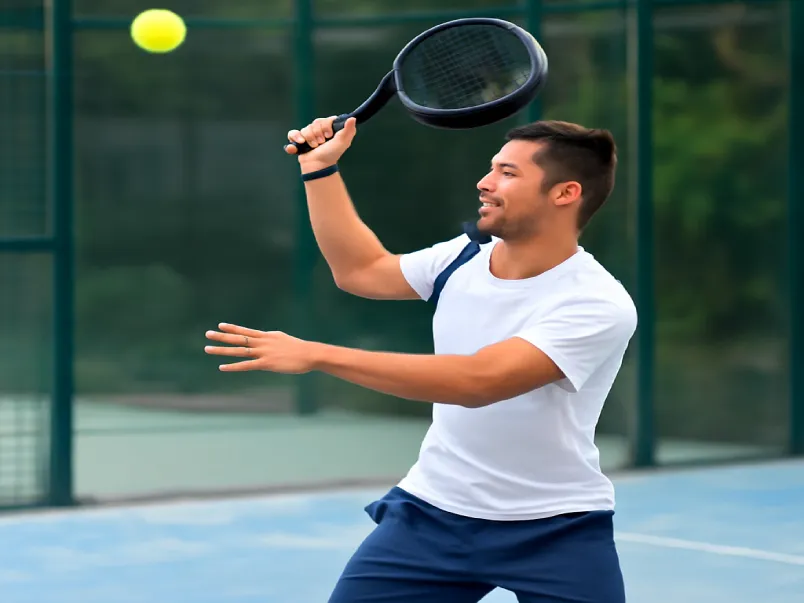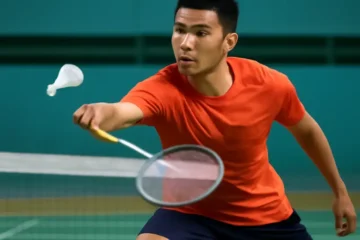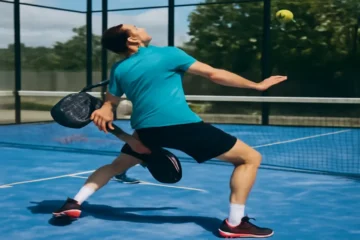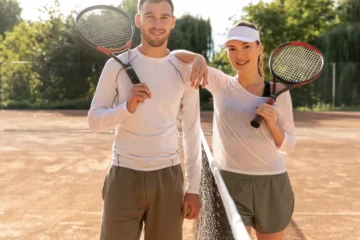Why the Bandeja is Your Secret Weapon
Imagine you’re at the net, feeling confident as you prepare for your next shot. But suddenly, your opponents hit a high lob that’s coming straight at you. You’re under pressure, your timing’s off, and you make a costly error. That’s a scenario many tennis players know all too well. It’s one of those moments where you feel like you’ve lost control of the point, but there’s a secret weapon that can help you regain it: the bandeja.
The bandeja, a controlled offensive shot often used in padel and tennis, offers a solution for moments like this. It’s not about winning the point outright, but about maintaining your net position, controlling the pace of the game, and creating opportunities for your team. By using the bandeja instead of a risky smash, you can turn what could be a defensive situation into one where you remain in control.
In this article, we’ll dive deep into the bandeja — what it is, why it’s a strategic asset in your game, how to execute it, and how to avoid common mistakes. Ready to take your game to the next level? Let’s get started.
Part 1: Understanding the ‘Why’ – The Strategic Role of the Bandeja
The bandeja is much more than just a shot. It’s a tactical weapon that helps you manage the flow of a match. Let’s explore the strategic benefits of the bandeja and why it’s so valuable for both amateur and professional players.
Regaining and Keeping the Net
When your opponents send a high lob your way, it often means they’re trying to push you off the net or force a weak return. The bandeja helps you maintain your net position, something that is crucial in doubles play, where controlling the net gives you a significant advantage. Instead of retreating or making an awkward overhead smash, the bandeja allows you to step forward, reset the point, and keep control of the net.
Neutralizing the Opponent’s Attack
A well-executed bandeja does more than just keep you in the point. It neutralizes your opponent’s lob and defuses their attack. While a smash may be an outright winner, the bandeja is a more strategic choice, one that keeps the point going and forces your opponents into a defensive position. You don’t need to go for a winner; you need to return the ball with precision, pushing your opponents off-balance and controlling the tempo.
Reducing Unforced Errors
One of the biggest challenges in tennis is avoiding unforced errors, particularly when dealing with high lobs. Attempting to smash the ball can be risky, often resulting in shots that go long or wide. On the other hand, the bandeja provides a much higher margin for error. By using a controlled slice and a more deliberate swing, you reduce the chances of missing the shot, making it a more reliable option.
Setting Up Your Partner
In doubles play, the bandeja isn’t just about you; it’s also about setting up your partner. A well-placed bandeja often results in a weak return from your opponents, which your partner can then put away. By using the bandeja strategically, you create opportunities for your team to capitalize on the point.
Part 2: Breaking Down the Mechanics – The 5 Key Phases of the Bandeja
The bandeja might seem simple, but there’s a lot of technical skill behind it. To master this shot, it’s essential to break it down into manageable steps. Here’s how to execute the bandeja, step by step.
Phase 1: The Preparation & Positioning
The first phase of the bandeja is all about positioning and preparation.
- The “V” Formation: In doubles play, you and your partner should be positioned in a “V” formation, with your partner at the net and you covering the baseline. This allows you to react quickly to lobs and transition smoothly between offense and defense.
- Reading the Lob: One of the keys to a successful bandeja is anticipating the lob. As soon as you see the ball heading high over your partner’s head, prepare to move into position. The earlier you can read the lob, the better your chances of executing the shot.
- The Sideways Position: When you recognize a lob coming, immediately turn your body sideways to the net. This positioning allows for greater control and helps you prepare for the next phase of the shot.
- Racket Preparation: As you rotate your body, take your racket back early and high, keeping your head up. This is the first step in setting up the “tray” concept, where your racket will resemble a tray carrying the ball.
Phase 2: The Grip and The Stance
Next, we’ll look at the grip and stance needed to hit a perfect bandeja.
- Grip: The Continental grip is essential for hitting the bandeja. It allows for a natural slice motion, which is key to controlling the ball and keeping it low after it bounces.
- Feet & Balance: You need to be on the balls of your feet, with your weight shifted slightly to your back foot. This stance ensures that you’re ready to transfer your weight forward during the shot, helping to generate power and control.
Phase 3: The Point of Contact
The contact point is where the magic happens.
- The “Tray” Concept: As the ball approaches, your racket face should be slightly open, resembling a tray. This allows you to create a slice, keeping the ball low and precise.
- Contact Point: The ideal contact point is out in front of your body, around shoulder or head level. By meeting the ball at the right height, you ensure that you can control its trajectory and direction.
- Arm Position: Your arm should be extended but not locked. The motion is more of a “pushing” or “blocking” action than a powerful swing, allowing for better control and consistency.
Phase 4: The Swing and Follow-Through
The swing and follow-through are where the technique comes together.
- The Motion: The bandeja’s swing is controlled and deliberate. It’s not a violent smash but a downward-and-forward motion that emphasizes control over power. The power comes from the rotation of your body and weight transfer rather than just your arm strength.
- Creating Slice: The open racket face and high-to-low swing path create backspin, which ensures the ball stays low after it bounces. This is one of the key elements of a successful bandeja.
- Follow-Through: The follow-through should be short and controlled, finishing across your body. Your racket will end up pointing towards the intended target area, allowing you to quickly recover and anticipate your opponent’s return.
Phase 5: The Recovery
After executing the bandeja, your work isn’t done.
- Immediate Movement: As soon as you hit the shot, you need to move forward towards the net to reclaim your position. This keeps the pressure on your opponents and prepares you for the next phase of the point.
- Anticipating the Return: Always be ready for the opponent’s likely weak response. By anticipating their next move, you’re better positioned to capitalize on the point.
Part 3: Drills to Master the Bandeja
Now that we’ve broken down the mechanics, let’s look at some practical drills that will help you master the bandeja.
Drill 1: The Shadow Swing
Before hitting the ball, practice the entire motion without a ball. This helps build muscle memory and allows you to focus on your footwork, swing, and follow-through.
Drill 2: The Feeder Drill
Have a partner feed you high lobs to a specific spot on the court. This drill lets you concentrate solely on your technique, ensuring that you’re hitting the bandeja with the right form.
Drill 3: The “X” Drill
Practice moving sideways along the baseline, simulating real-game movement. By hitting bandejas from different positions, you can improve your ability to react quickly and control the ball.
Drill 4: The Pressure Drill
This drill involves a continuous rally where the feeder only hits lobs, and you must respond with bandejas. Focus on consistency, depth, and placement rather than power.
Part 4: Common Mistakes and How to Fix Them
Mastering the bandeja involves learning from mistakes. Here are a few common errors and how to fix them.
Mistake 1: Using a Forehand Grip
A forehand grip can cause the ball to fly long. Fix: Re-grip to the Continental grip before the shot.
Mistake 2: Hitting the Ball Too Late
Hitting the ball too late, behind your body, results in a poor shot. Fix: Focus on early preparation and hitting the ball out in front of your body.
Mistake 3: Trying to Hit a Winner
Over-hitting the ball can result in errors. Fix: Repeat the mantra “Control, not power” and aim for depth and placement.
Mistake 4: Not Moving Your Feet
Reaching for the ball rather than adjusting your position can lead to inaccurate shots. Fix: Take small, adjustment steps to get perfectly positioned under the ball.
Conclusion: From Practice to Point-Winning
Mastering the bandeja is an ongoing process that takes time and repetition. However, with patience and consistent practice, it can become a cornerstone of your game, helping you to control the flow of points and create opportunities for you and your partner. Remember, it’s not about hitting a winner; it’s about making the right shot at the right time to maintain your position and keep your opponents on the defensive.
By focusing on control, precision, and position, the bandeja can be your secret weapon in turning challenging lobs into opportunities for success. Practice the technique, and soon enough, you’ll be executing bandejas with confidence and consistency.
FAQs (Frequently Asked Questions)
1. What is a bandeja in tennis?
A bandeja is a controlled, offensive shot typically used to respond to high lobs. Unlike the smash, which is a winner shot, the bandeja focuses on maintaining net position, reducing errors, and creating opportunities for your team by placing the ball strategically.
2. When should I use the bandeja in a match?
The bandeja is ideal when you’re under pressure from high lobs that come toward you at the net. It helps you regain control of the point by keeping the ball low and giving you time to reposition.
3. How is the bandeja different from a smash?
The bandeja is a more controlled, tactical shot compared to the smash. While a smash is intended to win the point immediately, the bandeja is designed to neutralize your opponent’s lob, allowing you to regain control of the point without taking unnecessary risks.
4. What grip should I use for a bandeja?
You should use the Continental grip, which allows you to create a slice and control the ball effectively. This grip is essential for consistency and precision during the shot.
5. Can the bandeja be used in doubles play?
Yes, the bandeja is especially useful in doubles play. It helps you maintain a strong net position and can set up your partner for a winning shot. A good bandeja forces your opponents into a defensive position, opening up opportunities for your team.
6. How can I practice the bandeja?
You can practice the bandeja using several drills, including the shadow swing (practice without a ball), feeder drills (focusing on technique), the “X” drill (moving laterally to simulate real-game conditions), and the pressure drill (focusing on consistency and placement under pressure).
7. What are the common mistakes when hitting a bandeja?
Some common mistakes include using the wrong grip (like a forehand grip), hitting the ball too late, over-hitting for power, or failing to move your feet properly. Each of these issues can be corrected with proper technique and practice.




